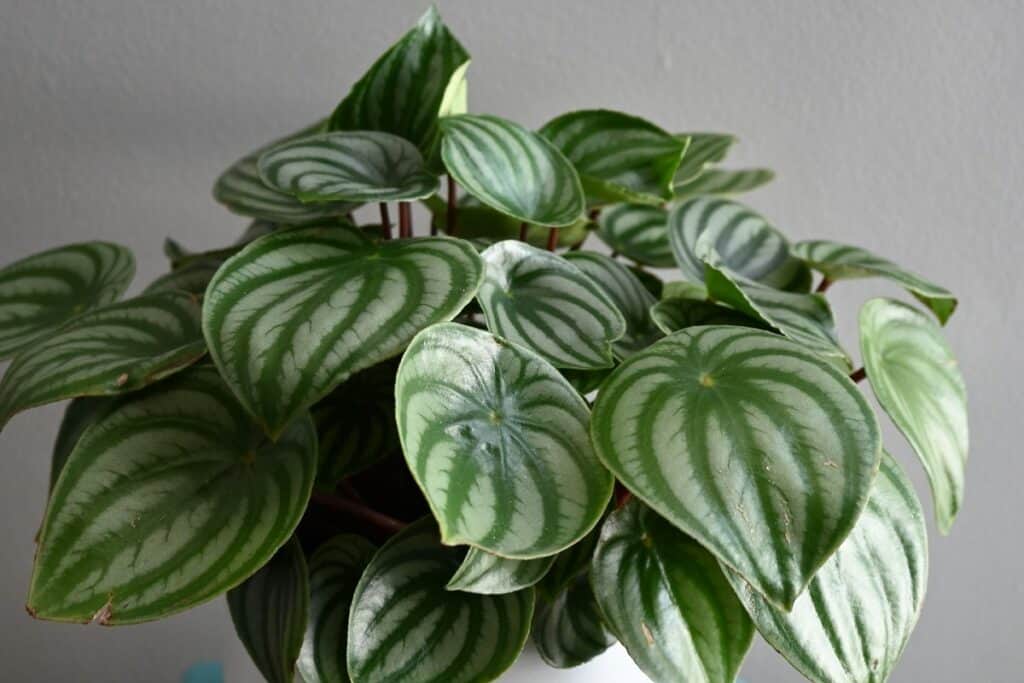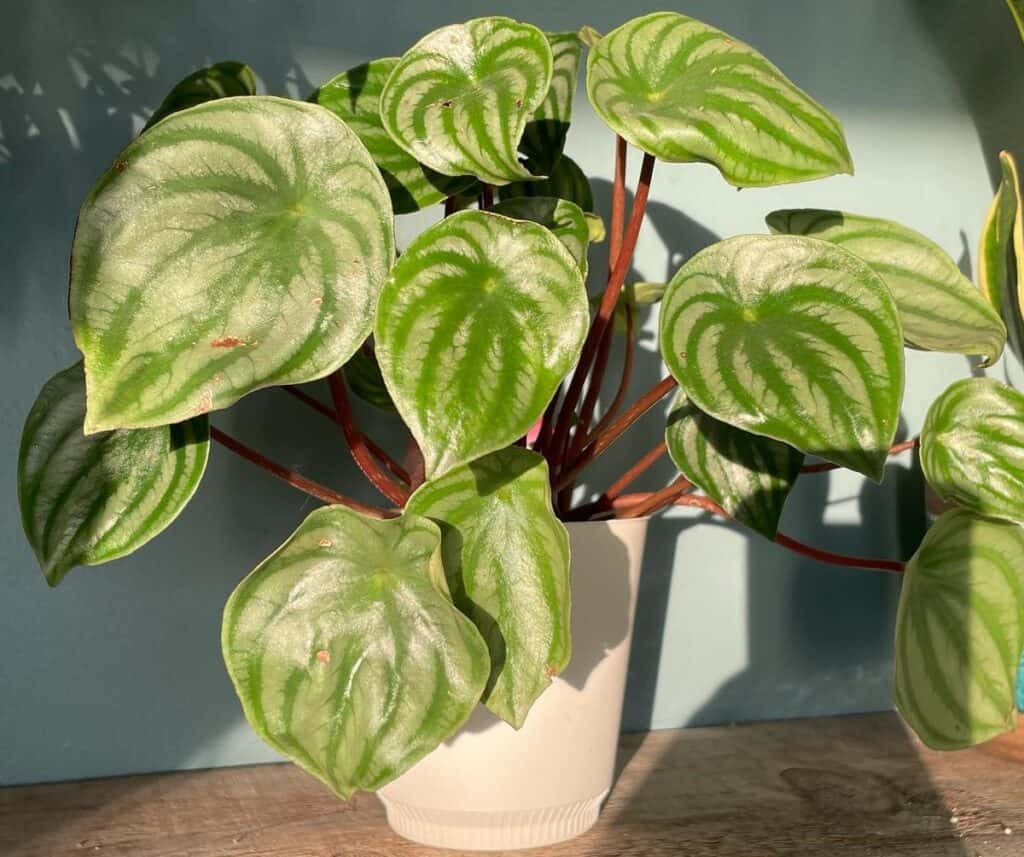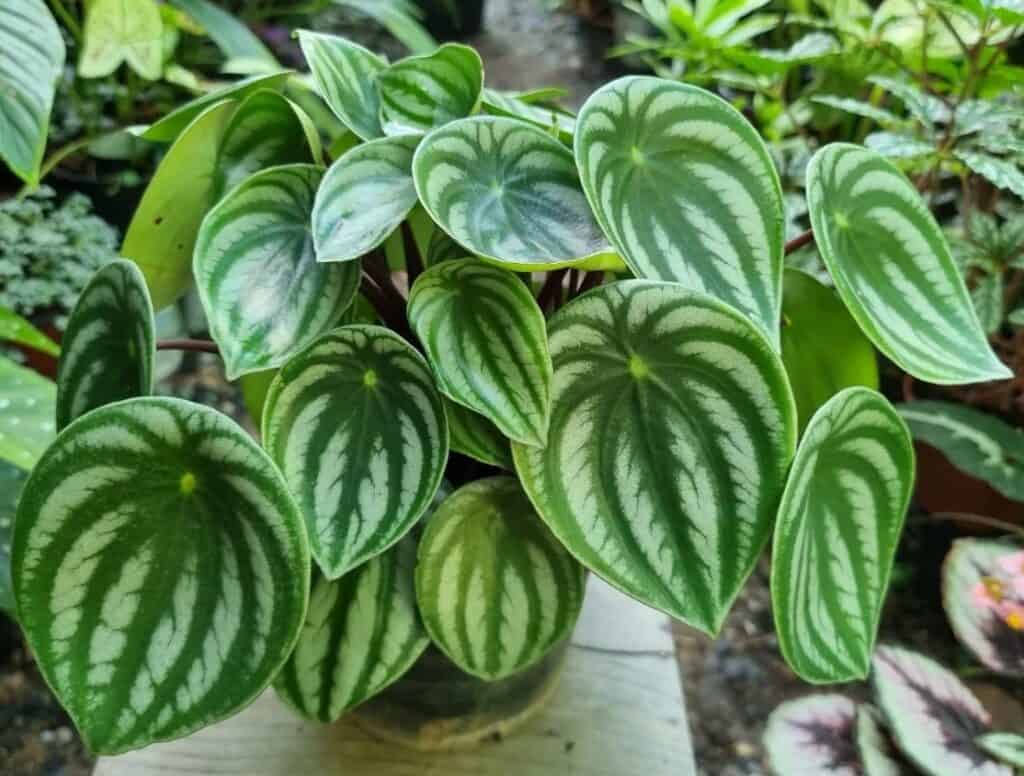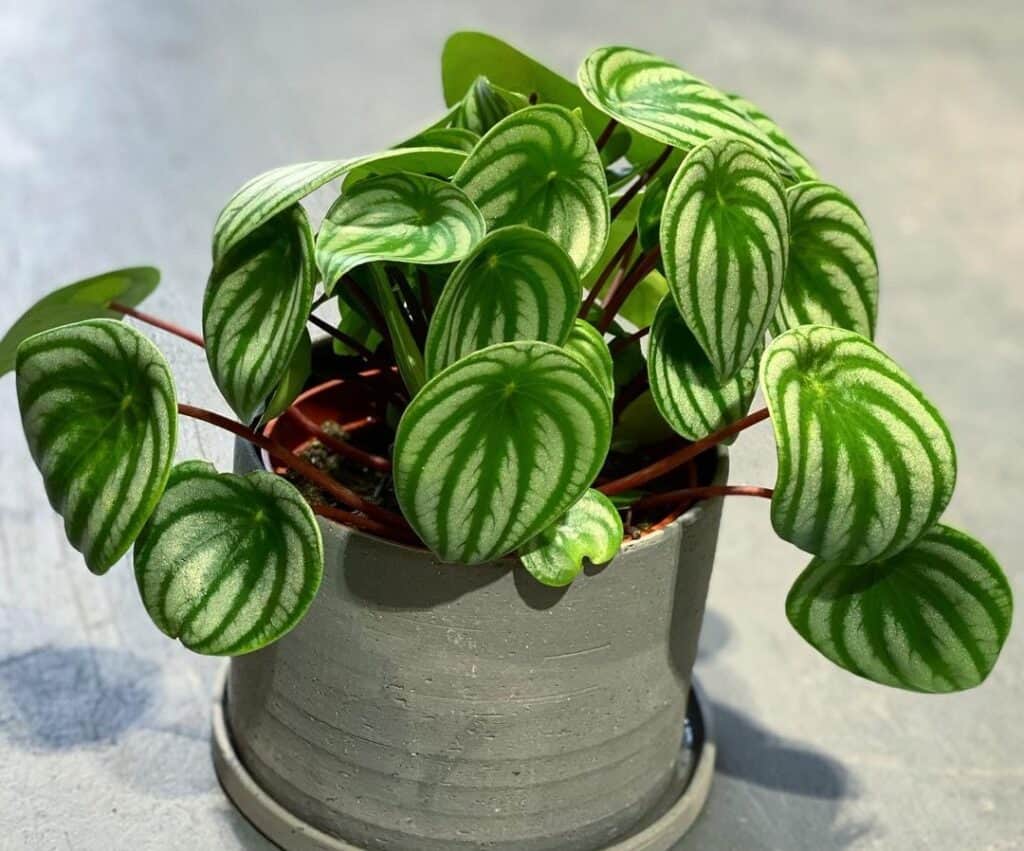Have you recently noticed your watermelon peperomia drooping and wilting? Read on to find out the 10 most likely causes of this common issue.

Watermelon peperomia is a popular houseplant with its beautiful foliage and unique coloration. However, sometimes this attractive plant can start to droop and wilt, and it can be an alarming sight for its owner. If your watermelon peperomia is drooping, you may be wondering what the cause of this is.
Contents
10 Causes Of Watermelon Peperomia Drooping
1. Overwatering
Overwatering is one of the most common causes of watermelon peperomia drooping. This is because watermelon peperomia are especially sensitive to too much water. Too much water can cause root rot, which can damage the plant’s roots and lead to drooping. The best way to avoid overwatering is to ensure that the soil is well-draining and to only water the plant when the soil is dry.
When watering the plant, it’s important to make sure not to water it too much. The best way to do this is to water the plant slowly and steadily until water begins to come out of the bottom of the pot. This ensures that the soil is evenly saturated and that there is no excess water that can cause root rot.
It’s also important to make sure the pot has adequate drainage holes, as this helps to ensure that water can escape quickly and doesn’t accumulate in the bottom of the pot. If the pot doesn’t have adequate drainage holes, it’s important to water the plant less and be extra cautious about not overwatering.
Finally, it’s important to be aware of the temperature and humidity of the environment in which the plant is growing. If the environment is too moist or too hot, the plant may need more or less water, so it’s important to adjust accordingly. By being careful about how much water the plant receives, it’s possible to avoid over-watering, which can prevent watermelon peperomia from drooping.
2. Underwatering
Underwatering is a common cause of watermelon peperomia drooping. When a plant is not receiving enough water, it will become dry and limp. The leaves will start to droop and the stems may look weak. If a plant is not watered regularly, it will not be able to absorb the necessary nutrients and moisture it needs to stay healthy.
The watermelon peperomia is a delicate plant, so it is important to make sure it is adequately watered. The plant prefers a moist environment, so it should be watered when the top layer of soil is dry. If the soil is kept too wet, the plant is at risk of root rot. To keep the soil evenly moist, it is best to water it thoroughly and then let it partially dry out before watering again.
3. Poor Soil Quality
The quality of the soil should be closely monitored to ensure that the plant has access to the nutrients it needs for optimal health. Poor soil quality can be caused by a variety of factors, such as poor drainage, compaction, or a lack of organic matter in the soil. These factors can lead to the watermelon peperomia not being able to take up the nutrients it needs, leading to drooping.
To improve the quality of the soil, it is important to add organic matter such as compost, peat moss, or manure to the soil. This will help to improve the drainage and aeration of the soil, as well as provide additional nutrients for the plant. If the soil is compacted, it may be necessary to break it up with a garden fork or tiller to improve drainage and aeration.
4. Too Much Light

Too much light can be a major cause of watermelon peperomia drooping. The plants prefer bright, indirect light but too much direct sunlight can cause the leaves to burn and the plant to wilt. If the plant is placed in an area of the house with too much light, the leaves may start to yellow, the stems will become weak, and the plant will start to droop.
To prevent too much light from causing drooping, ensure that the plant is placed in an area with bright, indirect light. This means that the plant should be placed in an area that receives a few hours of morning or afternoon sun but is protected from the harsh midday sun. If you are unsure about the amount of light in the area, it is best to err on the side of caution and place the plant in a spot that receives less direct light.
If the plant has already been exposed to too much light, it is important to act quickly. Move the plant to an area with bright, indirect light and adjust the watering schedule. Water the plant less frequently, but deeply, to ensure that the soil stays moist but not saturated. It may also help to mist the leaves of the plant to increase the humidity in the area.
Finally, ensure that the plant is placed in an area with good air circulation. Good air circulation will help to prevent the plant from getting too hot and wilting. If necessary, use a fan to create a breeze around the plant. With the right care, the watermelon peperomia should eventually recover from the damage caused by too much light.
5. Not Enough Light
Not enough light is a common cause of watermelon peperomia drooping. This is because this plant loves bright, indirect sunlight and thrives in partial shade. Without enough light, the leaves will start to droop and the plant will not be able to photosynthesize effectively.
If your peperomia is not receiving enough light, you may need to move it to a brighter location. If you are unable to do this, you can also consider adding a grow light to supplement the natural light. This will help the plant get the light it needs to stay healthy.
6. Too Much Fertilizer
Too much fertilizer can be a major cause of watermelon peperomia drooping. When fertilizer is applied in excess, it can lead to an overabundance of salts and minerals in the soil. This can damage the roots of the watermelon peperomia, making it unable to absorb enough water and nutrients, leading to drooping.
It is important to periodically check the soil for nutrient levels and if the levels are too high, the fertilizer should be reduced or stopped entirely. If you have already applied too much fertilizer, the best course of action is to flush the soil with plenty of water to help reduce the salt levels.
When applying fertilizer to a watermelon peperomia, it is important to follow the instructions on the package. Start with small amounts and increase gradually. It is also important to ensure that the fertilizer is evenly distributed throughout the soil. Too much fertilizer in one spot can cause burning of the roots and lead to drooping.
7. Pests
Pests can be one of the major causes of watermelon peperomia drooping. Insects such as mealybugs, spider mites, and scales can feed on the plant’s sap and cause discoloration and wilting of the foliage. In some cases, the plant may even lose its leaves due to pest infestation.
To prevent pest infestation, it is important to keep the plant’s environment clean and free of potential pests. This includes keeping the plant away from other plants that may be infested with pests, as well as keeping it away from areas where pests may be present, such as near windows and doors.
Make sure to check the plant regularly for signs of pests, such as webbing or discoloration of the foliage. If pests are found, it is important to treat the plant immediately with an appropriate insecticide or insecticidal soap. If the infestation is left untreated, it can cause serious damage to the plant and may even lead to its death.
8. Diseases
Watermelon peperomia, a tropical plant native to Central and South America, is popular with home gardeners due to its easy care and attractive foliage. Unfortunately, these plants can suffer from various diseases that can cause drooping.
The most common disease of watermelon peperomia is root rot, caused by a fungal infection. This is often caused by overwatering and poor drainage, which allows the fungus to grow and spread. Symptoms include yellowing of the leaves, wilting, and eventually drooping of the foliage. The best way to prevent root rot is to ensure that the plant is not overwatered and is planted in well-draining soil.
Another disease that can affect watermelon peperomia is powdery mildew. This fungal infection is caused by high humidity and poor air circulation. Symptoms include white spots on the leaves and stems, as well as yellowing and drooping of the foliage. To prevent this disease, make sure the plant is grown in a well-ventilated area with plenty of airflow.
Finally, watermelon peperomia can also be affected by leaf spot diseases, which are caused by fungi or bacteria. Symptoms of leaf spot diseases include dark spots on the plant’s leaves and stems, as well as leaf yellowing and drooping. To prevent these diseases, it is important to keep the leaves and stems of the plant dry and avoid overcrowding.
9. Temperature Stress

Temperature stress is a major cause of watermelon peperomia drooping. These plants are native to tropical regions, so they prefer warm temperatures that range between 68-85 degrees Fahrenheit (20-29 degrees Celsius). When temperatures drop below or rise above this range, watermelon peperomia can become stressed and droop.
In addition to the preferred temperature range, watermelon peperomia also require humidity. These plants need a humidity range of 40-60%, and if the air is too dry, the leaves can start to droop. In order to keep the humidity levels up, watermelon peperomia can be misted regularly with a spray bottle.
It is also important to pay attention to the temperature changes in the room. If the temperature suddenly drops, the plant might go into shock and droop. In order to prevent this, try to keep the plant away from windows, vents, and other sources of cold air.
Finally, be sure to monitor the temperature of the soil. If the soil gets too cold or hot, it can cause the plant to droop. To prevent this, you can use a soil thermometer to measure the temperature of the soil. If the soil is too cold, try adding a layer of mulch to insulate it.
10. Lack Of Pruning
Pruning is an important part of caring for Watermelon Peperomia, as it helps to promote the plant’s health and growth. When a plant is not pruned, it can start to droop over time due to the lack of energy and nutrients it needs to survive. Pruning helps to remove dead and dying leaves, stems, and branches, allowing the plant to focus its energy on healthy growth. Pruning also helps to promote air circulation, which is important for the plant’s overall health.
When a Watermelon Peperomia is not pruned, the plant may start to suffer from a lack of light, as the dead leaves and stems can block the light from reaching the healthy parts of the plant. This is especially true for plants kept in small pots or containers, where there is limited space for the plant to grow. Without the proper amount of light, the plant may become weak and start to droop.
Pruning also helps to control the size and shape of the Watermelon Peperomia, allowing it to be aesthetically pleasing. When the plant is not pruned, it can become too large and unruly, leading to an unattractive plant. Pruning helps to keep the plant looking neat and tidy by removing any excess foliage and encouraging the plant to grow in the desired direction.
What Should I Do If My Watermelon Peperomia Is Drooping?

If your Watermelon Peperomia, or Peperomia argyreia, is drooping, the first thing you should do is determine the cause of the drooping. There are a number of potential causes for Watermelon Peperomia drooping, such as too much or too little water, too much fertilizer, or too much direct sunlight.
Once you’ve identified the cause of the drooping, you can take steps to correct it. If your Watermelon Peperomia is drooping because of too much water, allow the soil to dry out completely before watering again. If it’s drooping due to too little water, give it a thorough soaking and then allow the soil to dry out slightly before watering again. If it’s drooping due to too much fertilizer, flush the soil with water to flush out the excess fertilizer. If it’s drooping due to too much direct sunlight, move it to a spot with indirect sunlight, as Watermelon Peperomias do best in bright, indirect light.
If the drooping persists, check the roots of the Watermelon Peperomia for signs of root rot, such as dark, mushy roots. If root rot is present, remove the plant from its pot and cut away the affected roots. Repot the plant in a new pot with fresh, sterile potting mix and water it lightly.
Finally, if your Watermelon Peperomia is still drooping after taking the steps above, it’s possible that the plant is not getting enough nutrients or has been affected by pests. Consider adding a balanced fertilizer to the soil, or checking for signs of pests, such as aphids or mites. With a little bit of care, your Watermelon Peperomia should soon recover.
How Can I Prevent My Watermelon Peperomia From Drooping?
The Watermelon Peperomia, a member of the Piperaceae family, is a colorful and eye-catching houseplant that adds a beautiful pop of color to any home. Unfortunately, these plants can be prone to drooping, but there are a few steps you can take to help keep your Watermelon Peperomia healthy.
The first step to preventing drooping is to ensure your Watermelon Peperomia is getting enough light. These plants prefer bright, indirect light, so it’s best to keep them near a window that gets plenty of sunlight. Additionally, you should also make sure to water your plant regularly and make sure the soil is moist but not saturated.
Another important factor to consider is the temperature and humidity levels in your home. Watermelon Peperomia plants prefer temperatures between 65-80 degrees Fahrenheit and prefer humid environments. If the humidity in your home is too low, you can increase it by misting your plant with water or using a humidifier.
Finally, it’s important to remember that Watermelon Peperomia plants are susceptible to a range of pests and diseases, so it’s important to check for signs of infestation or infection. The best way to do this is to inspect your plant regularly and remove any pests or diseased leaves when necessary.
By following these tips, you can help ensure that your Watermelon Peperomia stays healthy and vibrant. With the right amount of light, moisture, and attention, your plant should be able to thrive and stay free from drooping.
Conclusion
Overall, watermelon peperomia drooping is a common issue that can be caused by a variety of factors. From under-watering and overwatering to pests and diseases, the causes of this issue are wide-ranging. It is important to pay attention to the environment and care of your plant to ensure it is healthy and thriving. With proper care and attention, your watermelon peperomia can stay healthy and look beautiful!
